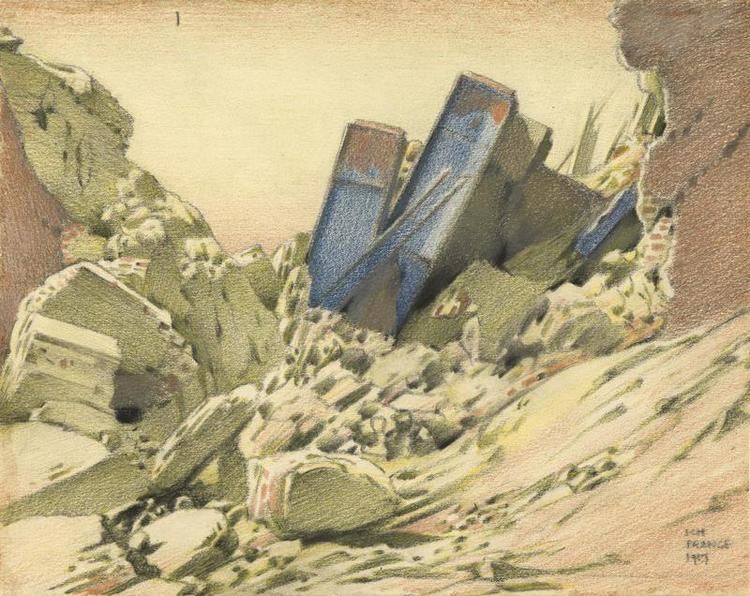Nationality Scottish Name Keith Henderson Died 1982, South Africa | Known for painting Role Painter Books The Worm Ouroboros | |
 | ||
Born 17 April 1883 Scotland Similar People Eric Rucker Eddison, Wilhelm Groener, Helmuth von Moltke the Youn, Erich Ludendorff, Paul von Hindenburg | ||
Keith Henderson OBE RP RSW RWS ROI (17 April 1883 – 24 February 1982) was a Scottish painter who worked in both oils and watercolours, and who is known for his book illustrations and his poster work for London Transport and the Empire Marketing Board. He had a long professional career that included periods as a war artist in both the First World War, in which he served in the trenches, and in the Second World War.
Contents
Early life and First World War
Henderson was born in Scotland and brought up in Aberdeenshire and in London, where his father worked as a lawyer. He attended Orme Square School in London and Marlborough College. Henderson studied at the Slade School of Art before continuing to develop his art at the Academie de la Grande Chaumiere in Paris. While in Paris he shared a studio with Maxwell Armfield. During the First World War he served on the Western Front. He depicted his experiences of warfare there in several paintings and in a book, Letters to Helen: Impressions of an Artist on the Western Front, first published in 1917.
Between the two world wars Henderson travelled extensively in Africa and South America and would later include images of the flora and fauna he saw on these trips in his book illustrations. Henderson worked as an illustrator, designing posters and book jackets. He illustrated books by W. H. Hudson and Eric Rucker Eddison, including The Worm Ouroboros, and, with Norman Wilkinson, an edition of Geoffrey Chaucer's translation of The Romaunt of the Rose. He produced poster designs for both London Transport and the Empire Marketing Board, who sent him to paint in Cyprus for over a year.
He also exhibited his work, at the Royal Academy and a solo show of paintings of Cyprus at the Beaux Arts Gallery at Bruton Place in London.
In August 1927, Henderson wrote a letter to The Times, giving his address as "Eoligarry, Isle of Barra, Outer Hebrides". He also lived at Glen Nevis and, from 1942, for several years at Spean Bridge. Henderson also worked in South Africa, Cyprus and Egypt.
Second World War
At the start of the Second World War, Henderson was one of the first two artists, alongside Paul Nash, appointed as a full-time salaried artist to the Air Ministry by the War Artists' Advisory Committee, WAAC. Henderson was sent to RAF bases in Scotland but was frustrated to find that William Rothenstein, although not contracted to WAAC at the time, had already visited many of the same bases and made many of the portrait drawings Henderson was due to paint. This led Henderson to concentrate on ground crew, aircraft hangars, repair shops and runways. Although the painting An Improvised Test of an Under-carriage provoked fury in the Air Ministry and contributed to Henderson's six-month contract not being extended, it was among the artworks shown at the first WAAC Britain at War exhibition at the Museum of Modern Art in New York in May 1941. The painting shows a man jumping up and down on the wing of a Lockheed Hudson to test the undercarriage.
Although disappointed his appointment had not been extended, Henderson continued to paint war subjects. Among these paintings was Loading Gantry for Pluto, which shows the giant gantry at W. T. Glover and Co. used for preparing the cables to be laid under the Channel to supply fuel to Allied forces in France.
Later life
After the Second World War Henderson continued to paint, although his style changed somewhat. By the 1970s he was painting groups of figures in minimal settings, often against all-white backgrounds. His wife, Helen died in 1971 "after nearly sixty perfectly wonderful years together". After an interval of great heart searching he moved to London, having sold their Scottish home and his complete collection of pictures and books. During the last twenty years of his life, Henderson engraved over sixty illustrations for a book on Assyrian, Egyptian and Greek mythology which he titled Creatures and Personages, but which remained unpublished at the time of his death.
He was an active member, and major benefactor, of the Royal Watercolour Society until his death in 1982 in South Africa. Works by Henderson are held in numerous Scottish collections, as well as the Imperial War Museum, the RAF Museum and the National Gallery of Canada.
